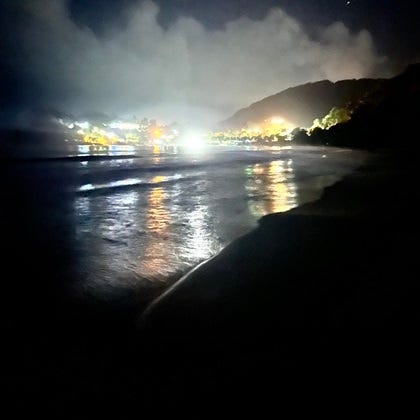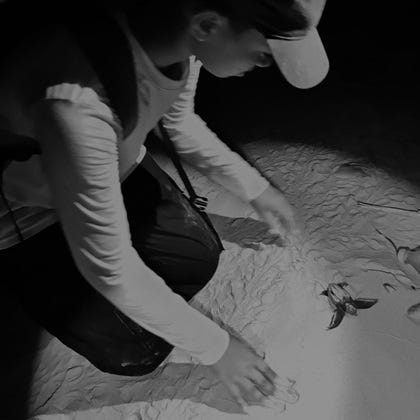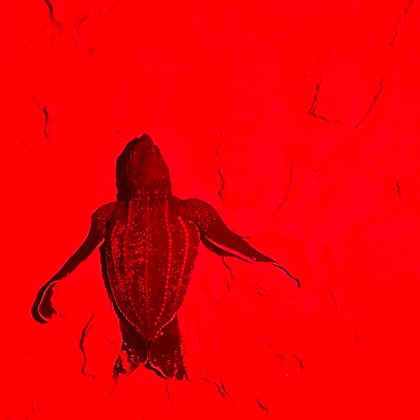In the dark of a warm tropical night, my 11-year-old son and I walked the length of Las Cuevas beach in northern Trinidad, scanning the shore with red-filtered torches.
We were with Arlene Williams, President of the Las Cuevas Eco-Friendly Association, a local community group devoted to protecting the sea turtles that nest on the beach each year. Her dedication to this cause makes her a conservation hero, but she is worried about how long she can keep going.
Arlene and other local residents began patrolling the beach in 2010 after finding the carcasses of sea turtles that poachers had killed for their meat. Las Cuevas is a vital habitat for these animals — five species of sea turtles nest there, with endangered leatherbacks being the most common. Both adults and hatchlings face many dangers. Poaching remains a problem, though less frequent. Stray dogs also roam the beach, preying on eggs and hatchlings. And vehicles, driven carelessly along the shore, often damage nests, crushing the fragile eggs beneath.
Recognizing the efforts of Arlene and her fellow patrollers, a nongovernmental organization called the Turtle Village Trust stepped in to help. It provided training, teaching the group how to handle nesting turtles, record essential data and tag the animals for long-term monitoring.
In 2013, Arlene's group registered as the Las Cuevas Eco-Friendly Association. Its mission is to make Las Cuevas the safest beach in Trinidad for nesting sea turtles and their hatchlings while creating employment within the rural community.
From 1 March to 31 August each year, members of the association patrol the 2.2-km-long beach nightly, typically from 8:00 pm to 2:00 am. Arlene told us that during the peak season, as many as 40 female turtles might come ashore on a single night to lay their eggs. But our visit, late in this year’s nesting season, wasn’t likely to offer such a sight. The previous night, she had only seen one loggerhead.
As we neared the far end of the beach, having seen no trace of a turtle, I explained to my son that we might not be lucky. He had already reached that conclusion. Arlene had moved ahead, leaving us alone in the darkness. We stared into the breaking waves, hoping that a turtle would emerge. None did.
“I’m sad,” he said. I felt bad for having raised his hopes.
“Me too,” I replied.
We caught up with Arlene and turned back towards the fishing village, its lights bright in the distance. It seemed the beach would remain quiet that night. But just when we thought we’d leave disappointed, Arlene spotted a nest.
We hurried over to find a stream of leatherback hatchlings hauling themselves out of the sand. Palm-sized and determined, they moved like wind-up toys, flicking their flippers relentlessly to reach the sea. My son crouched down beside me, his sadness replaced with awe.
With Arlene’s guidance, we gently helped orient the hatchlings towards the ocean. I was surprised at how warm they felt in my hands. We watched as, one by one, they began their journey across the sand towards the waves. It was a privilege to witness the first moments of their lives.
We found three more nests that night, each one releasing about a hundred hatchlings into the world. Arlene explained that only one in a thousand would survive to adulthood. If they did, the females would return to this very beach to lay their eggs—20 to 25 years from now.
Watching them disappear into the ocean filled me with a mix of hope and uncertainty. The world is changing fast, and the turtles face growing challenges. Arlene spoke of the impacts of climate change: rising seas and heavier rains are compacting the sand, making it harder for hatchlings to escape their nests. She hopes one day to buy incubators so she can protect eggs from nests that are damaged or too close to the sea.
“You have a dream job,” I said to her.
“This isn’t my job,” she corrected me with a smile. “We’re volunteers.”
For years, the beach patrollers received a nightly stipend from the Trinidad and Tobago government’s Green Fund, funneled through the Turtle Village Trust. It was enough to make turtle-protection a livelihood. But that funding ended in 2018. This forced most of the volunteers to quit, leaving only Arlene and her partner Simba there most nights. By patrolling the beach, unpaid, for seven years, they have protected hundreds of adult sea turtles and saved thousands of hatchlings from predators and human disturbance.
What makes their dedication even more remarkable is that Arlene and Simba have been living without electricity for the past five years. The Trinidad and Tobago Electricity Commission told them they would need to pay US$7,000 for a transformer. Slowly, by saving tips from tourists, they are inching closer to that goal. But the struggle is real, and the future of the patrols remains uncertain.
As I watched the final hatchling reach the sea and disappear into the waves, I allowed myself to believe that it was a female and that it would survive. In the years to come, I will think of it often, somewhere in the vast, warming ocean, navigating the currents and eating countless jellyfish. And when it finally returns to Las Cuevas, I hope that Arlene—or someone as dedicated as her—will be there to welcome it home.
Support for Arlene and Turtle Conservation
To help Arlene and Simba continue their crucial work, I’ve set up a GoFundMe. For the rest of the year, I’ll also donate 50% of the income from new paid subscriptions to my Global Nature Beat newsletter. The funds raised will first go towards paying for the transformer to bring electricity to their home. Any amount beyond that will directly support their turtle conservation efforts on Las Cuevas Beach. You can hear about that work from Arlene in the video below.








One of my favorite memories from growing up in South Florida was finding turtle nests hatching. All of the houses there covered their lights that faced towards the ocean, since the little ones would go the wrong way if they saw the bright lights. We used to scoop up the sand beneath the ones heading the wrong way and ferry them to the water, past the birds that were eyeing them. And for the very wayward ones, the turtle rehabilitation center had a cooler on a post, like a cold mailbox, that you could drop off any found turtles in at any time - they would take care of them and get them ready to release when they had grown enough to be likely to survive. Thank you for the article, I'm happy you got to experience that!
This is mighty work Mike.